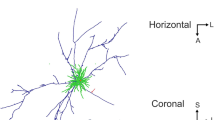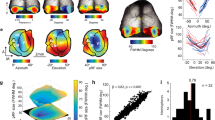Abstract
Striking correlations between structure and function are found in the visual cortex of Old World primates1–4. These include the co-localization of glutamic acid decarboxylase (GAD, the biosynthetic enzyme of the inhibitory neurotransmitter, γ-aminobutyric acid) with the mitochondrial enzyme, cytochrome oxidase (CO)5 in functionally distinct subcompartments6,7 of ocular dominance columns3,4,8. We report here immunocytochemical studies with a monoclonal antibody (CAT 301)9 showing that the antibody recognizes an uncharacterized antigen on surfaces of some neurones in certain layers of the monkey striate cortex (area 17), and in certain parts of the cat and monkey dorsal lateral geniculate nuclei (LGN). Patches of immunocytochemically stained neurones and neuropil, apparent in layers III, IVB and VI of the striate cortex of normal monkeys, become even more clearly delineated in animals from which one eye has been removed. The antibody-stained patches in the three layers line up radially with one another in lines passing through the centres of ocular dominance columns (demonstrable by CO staining in layers IVA and IVC). In layers III and VI the patches coexist with CO-positive patches3,4 and, in the horizontal dimension, both antibody and CO-positive patches are aligned to form rows. Stained neurones in the monkey LGN are primarily in the magnocellular layers and in the cat LGN are confined to laminae A and A1, the inter-laminar plexuses, the perigeniculate nucleus and the medial inter-laminar nucleus. The antigen we have localized is associated with particular cell populations, some of which may correspond to a specific, physiological class.
This is a preview of subscription content, access via your institution
Access options
Subscribe to this journal
Receive 51 print issues and online access
$199.00 per year
only $3.90 per issue
Buy this article
- Purchase on Springer Link
- Instant access to full article PDF
Prices may be subject to local taxes which are calculated during checkout
Similar content being viewed by others
References
Hubel, D. H. & Wiesel, T. N. J. comp. Neurol. 158, 267–294 (1974).
Hubel, D. H. & Wiesel, T. N. Proc. R. Soc. B 198, 1–59 (1977).
Horton, J. C. & Hubel, C. H. Nature 292, 762–764 (1981).
Livingstone, M. S. & Hubel, D. H. Proc. natn. Acad. Sci. U.S.A. 79, 6098–6101 (1982).
Hendrickson, A. E., Hunt, S. P. & Wu, J.-Y. Nature 292, 605–607 (1981).
Hubel, D. H. & Livingstone, M. S. Soc. Neurosci. Abstr. 7, 357 (1981).
Hubel, D. H. & Livingstone, M. S. Soc. Neurosci. Abstr. 8, 706 (1982).
Humphrey, A. L. & Hendrickson, A. E. Soc. Neurosci. Abstr. 6, 315 (1980).
Hockfield, S. & McKay, R. Proc. natn. Acad. Sci. U.S.A. 79, 6747–6751 (1982).
Hockfield, S. & McKay, R. Proc. natn. Acad. Sci. U.S.A. 80, 5758–5761 (1983).
Wong-Riley, M. Brain Res. 171, 11–28 (1979).
Wiesel, T. N., Hubel, D. H. & Lam, D. M. K. Brain Res. 79, 273–279 (1974).
Humphrey, A. L. & Hendrickson, A. E. J. Neurosci. 3, 345–358 (1983).
Hendrickson, A. E. & Wilson, J. R. Brain Res. 170, 353–358 (1979).
Graybiel, A. M. & Ragsdale, C. W. Jr Nature 299, 439–442 (1982).
Rockland, K. S. & Lund, J. S. J. comp. Neurol. 216, 303–318 (1983).
Schiller, P. H. & Malpeli, J. G. J. Neurophysiol. 40, 788–797 (1978).
Wiesel, T. N. & Hubel, D. H. J. Neurophysiol. 35, 1118–1139 (1966).
Dreher, B., Fukada, Y. & Rodieck, R. W. J. Physiol., Lond. 258, 433–452 (1976).
Dreher, B. & Sefton, J. J. comp. Neurol. 183, 47–64 (1979).
Wilson, P. D., Rowe, M. H. & Stone, J. J. Neurophysiol. 39, 1193–1209 (1976).
Barnstable, C. J. Nature 286, 231–235 (1980).
Lemmon, V. & Gottlieb, D. I. J. Neurosci. 2, 531–535 (1982).
Giotta, G. in Monoclonal Antibodies to Neural Antigens (eds McKay, R., Raff, M. C. & Reichardt, L.) 51–60 (Cold Spring Harbor Laboratory, New York, 1981).
Hockfield, S., McKay, R., Hendry, S. & Jones, E. G. Cold Spring Harb. Symp. quant. Biol. (in the press).
Brodmann, K. J. Psychol. Neurol. 4, 177–226 (1905).
Lund, J. S. J. comp. Neurol. 147, 455–496 (1973).
Author information
Authors and Affiliations
Rights and permissions
About this article
Cite this article
Hendry, S., Hockfield, S., Jones, E. et al. Monoclonal antibody that identifies subsets of neurones in the central visual system of monkey and cat. Nature 307, 267–269 (1984). https://doi.org/10.1038/307267a0
Issue Date:
DOI: https://doi.org/10.1038/307267a0
This article is cited by
-
The roles of perineuronal nets and the perinodal extracellular matrix in neuronal function
Nature Reviews Neuroscience (2019)
-
GABAergic neuronal populations in monkey primary auditory cortex defined by co-localized calcium binding proteins and surface antigens
Experimental Brain Research (1992)
-
Varicosity-associated antigens define neuropile subfields in the leech central nervous system
Journal of Neurocytology (1985)
Comments
By submitting a comment you agree to abide by our Terms and Community Guidelines. If you find something abusive or that does not comply with our terms or guidelines please flag it as inappropriate.



